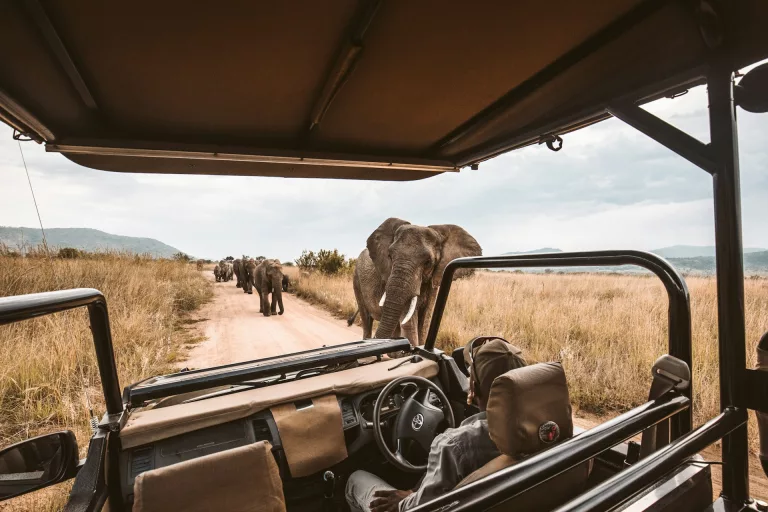It’s the ultimate African travel dream: seeing lion, leopard, rhino, elephant, and buffalo in their natural habitat. But the price tags of luxury safari lodges can feel intimidating.
The good news? A Big Five safari doesn’t have to be a once-in-a-lifetime splurge. With the right planning, a bit of flexibility, and a DIY spirit, you can enjoy an unforgettable safari—even on a tight budget.
Here’s how to experience the thrill of the Big Five without emptying your bank account.
Go for national parks over private reserves
Etosha National Park/Anna Sullivan/Unsplash
Private reserves offer exclusivity, but often at eye-watering prices. If your priority is wildlife over spa treatments, national parks are your best bet. They’re more affordable, often have excellent self-driving routes, and still offer a real chance of spotting the Big Five.
Some top options:
- Kruger National Park, Mpumalanga—The gold standard for budget safaris. Easy self-drive routes, budget rest camps, and reliable Big Five sightings.
- Addo Elephant National Park, Eastern Cape—Malaria-free, family-friendly, and known for its large elephant population.
- Hluhluwe-iMfolozi Park, KwaZulu-Natal—one of the best places to see white rhino.
- Etosha National Park, Namibia—A surreal, salt-pan safari experience where animals congregate around waterholes.
- Mikumi National Park, Tanzania—An underrated and more affordable alternative to the Serengeti.
If you’re planning multiple park visits in South Africa, consider investing in a SANParks Wild Card—it offers unlimited access to national parks for a set period.
Travel in the off-season
Safari prices spike during the dry winter months (June–August) and the festive season. Instead, consider the green season—summer months when rains bring dramatic skies, lush scenery, and discounted accommodation. While spotting wildlife may be trickier due to thicker bush, experienced guides still deliver solid sightings.
Best off-peak months:
- January–March—After the holiday rush, before Easter.
- September–early November—Mild weather, fewer crowds.
You’ll likely have fewer vehicles around you at sightings—a win for both budget and experience.
ALSO READ: Jason Gipson of Lion Sands Game Reserve wins Safari Guide of the Year 2025
Consider a self-drive safari
Skip the guided drives and opt to explore the park on your own. Self-driving is one of the best ways to cut costs and move at your own pace. Many parks (especially in South Africa and Namibia) are well signed, easy to navigate, and have good road infrastructure.
Ideal for self-driving:
- Kruger—Multiple rest camps, picnic spots, fuel stations, and sighting boards.
- Addo—compact enough for easy day trips.
- Etosha—famous for waterholes where animals gather.

Red Charlie/Unsplash
Stay in rest camps, campsites, or budget lodges
You don’t need a private plunge pool to enjoy the bush. Many rest camps and community-run lodges offer simple but comfortable stays in prime locations.
Try these wallet-wise options:
- SANParks Rest Camps—Book early for places like Skukuza or Satara in Kruger.
- Community conservancy campsites—especially in Namibia and Botswana.
- Bushveld backpackers or safari hostels—found near parks like Hazyview (Kruger) or Kasane (Chobe).
Most offer optional add-ons like night drives or guided bush walks, so you still get access to rangers and expert knowledge when needed.
Join a group tour or shared safari
If self-driving isn’t your thing, look for shared budget safaris. These typically bundle accommodation, park entry, and game drives at a lower per-person rate.
You’ll find affordable packages from:
- Nomad Africa – Overland trips across Southern and East Africa.
- Local operators in Nelspruit, Nairobi or Windhoek – Often have great-value 2–5 day trips.
- G Adventures or Intrepid – Known for small-group, budget-conscious trips.
You’ll meet other travellers and get expert insights from local guides.
Cut daily costs with smart packing
Keep your costs down by avoiding overpriced park restaurants and souvenir shops, and bring:
Your own food—Shop at local supermarkets before entering the park.
Reusable water bottles and a filter—Avoid buying bottled water.
Basic gear—torch, binoculars, power bank, and a wide-brim hat.
Prepaid SIM card with local data—for maps and park apps.
Some SANParks rest camps have shared kitchens and braai areas—perfect for cooking your own meals.
Yes, the Big Five are iconic. But there’s so much more to safari than ticking off a list. Watching a giraffe graze in the golden hour or hearing the distant whoop of hyenas is equally memorable. Some of the best stories come from the “in-between” moments.
Follow us on social media for more travel news, inspiration, and guides. You can also tag us to be featured.
TikTok | Instagram | Facebook | Twitter
ALSO READ: Weekend road trips that won’t wear you out

